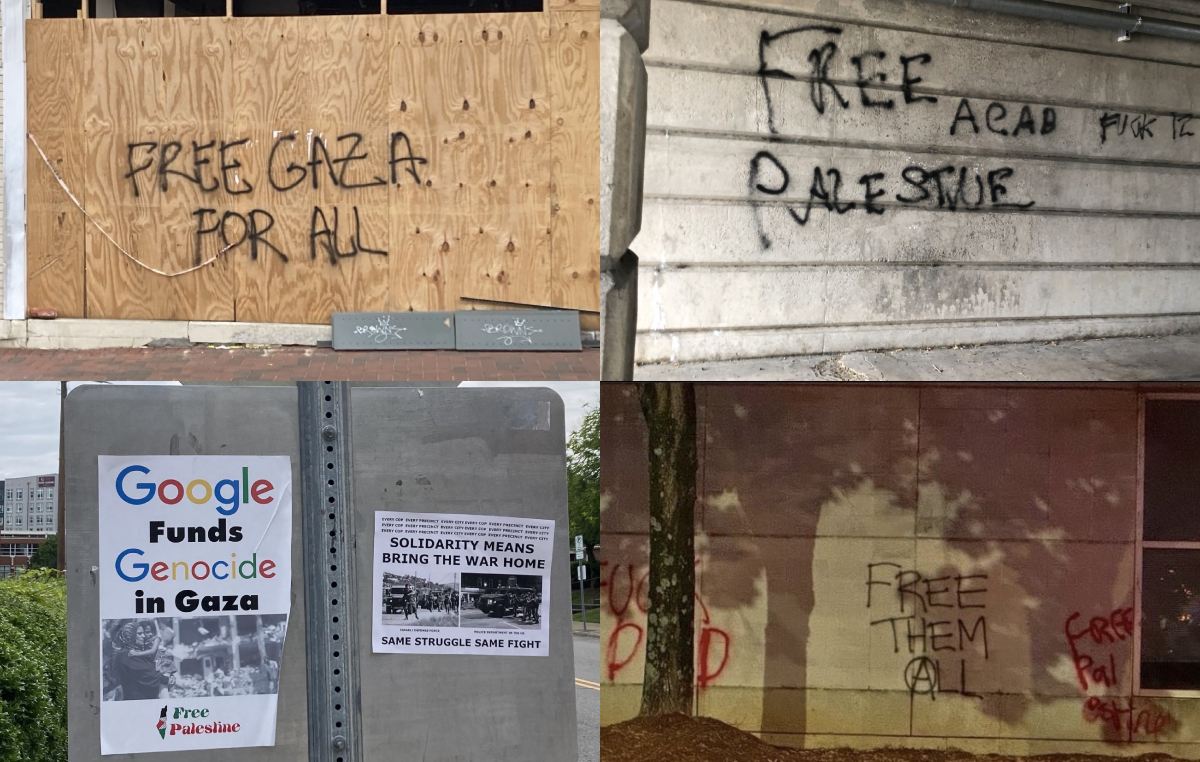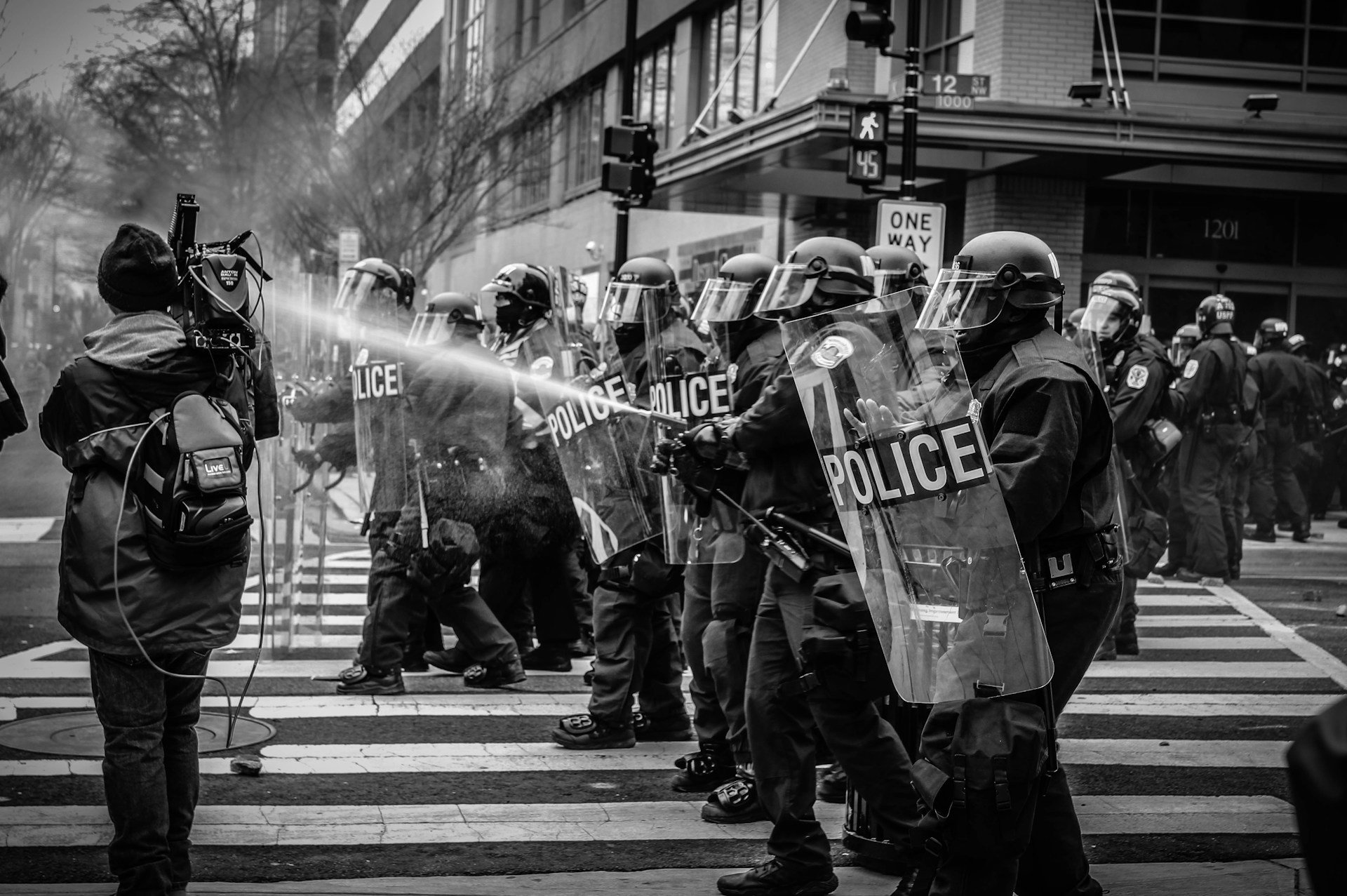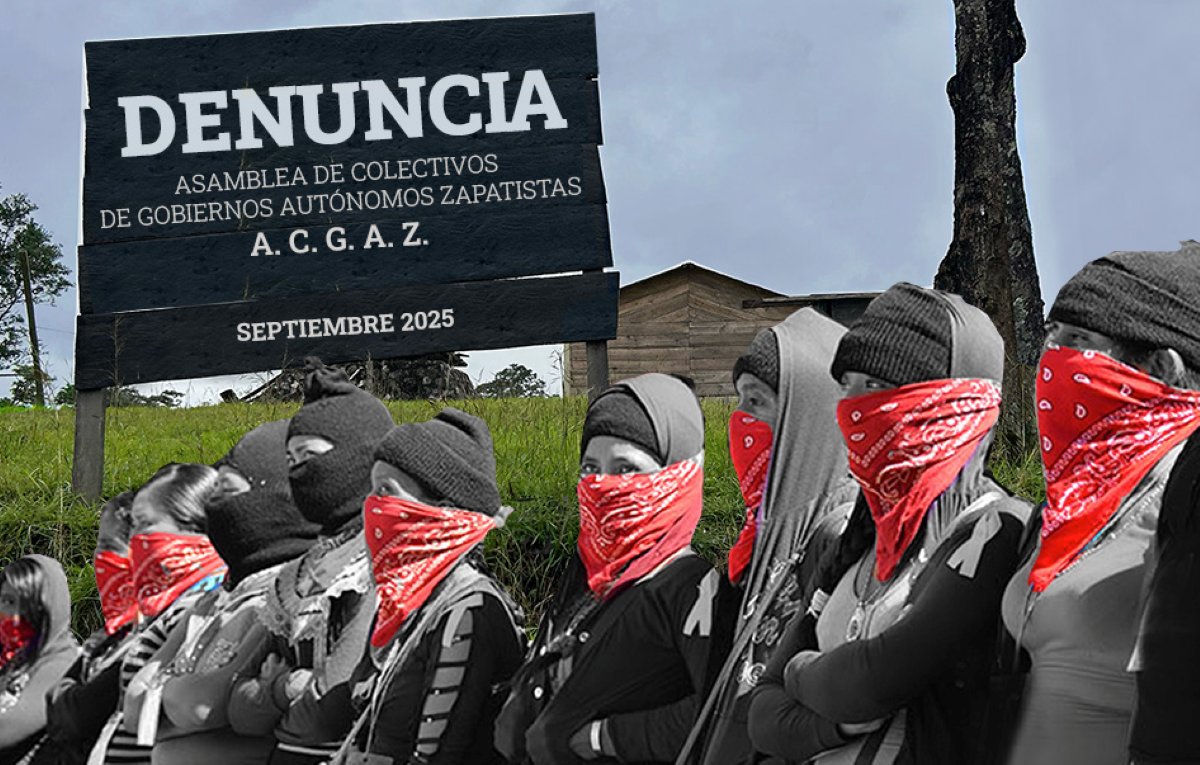Filed under: Action, Solidarity, Southeast, Technology, War

Report back from Durham, North Carolina on recent autonomous march in solidarity with Palestine.
On the night of June 1st, a crowd of 80-100 people marched in downtown Durham in solidarity with the struggle for a free Palestine. While the march was smaller than a similar one in January, in other important ways it felt like a positive step in developing our ability to act and move together in the streets.
I was not involved in the initial call or organizing of the demo, but given the tendency of the local institutionalized Left to invisibilize or disarticulate these actions, I wanted to contribute a brief reportback. Hopefully others who participated also feel encouraged to share their own reflections and ideas, as we continue to develop our capacity for collective strategy, courage, self-organization, and constructive critique.
The March
The event began, like so many other demos, at CCB plaza in downtown. As people gathered a table was set up with zines covering the recent student occupations, writings by Palestinians, and a large number of how-to oriented texts. There were also handbills for local anarchist projects, posters, cans of spray paint, brushes and bottles of wheatpaste.
After one person in full bloc gave a brief speech declaring that this was a space where we would be supporting rather than policing each others’ rage or grief, a short open mic ensued. A Black trans woman gave a beautiful speech about Palestine and 2020, another invoked the spirit of the Stonewall riots, and an Iraq war veteran, who was just walking by the plaza when he happened upon the demo, spoke emotionally about the brutality of the American and Israeli military campaigns. Several huge banners present declared our solidarity with Gaza as a struggle that is also against borders, states, and prisons.
The march left soon after, snaking its way through downtown and, as it so often does, towards the jail. When it reached the jail, some folks almost immediately started painting the walls, and the large glass façade was smashed. Within fifty yards, however, DPD deployed a long two deep line of riot police blocking S. Mangum St. Whether it was to prevent the march from taking the highway or to prevent its interaction with a large concert under way at the nearby stadium, this was the first time I’ve seen riot police deployed in Durham in four years.
Numbers were nowhere near what the crowd would have needed to push through that line, and marchers were in a tight spot without side exits, with motorcycle pigs tailing behind. I thought the front of the crowd made a really smart decision to pause, communicate, and pull a U-turn, and the crowd stayed calm, shouting directions and keeping a sustainable pace while it wound its way through and past the rear line of police. Its not clear if the police intended to kettle marchers — the motorcycle cops weren’t enough to contain the crowd, but if folks had lacked communication and frozen, DPD might have been able to move in more cops at the rear and things could have gotten ugly.
This escape left people free to keep marching, and the march continued to do so for at least another hour or so. Despite some tense moments with an extremely aggressive Dodge Charger, the march kept itself tight and safe, continuing to paint walls and sidewalks, wheatpasting posters, and handing out flyers to (mostly) supportive drivers. Back near CCB plaza, a new Google office got paint-bombed and hit with rocks, to the sound of cheering. Google has increasingly come underfire for its involvement with Project Nimbus, a $1.2 billion agreement between the Israeli government, Google, and Amazon, which provides cloud computing and artificial intelligence services to the Israeli Military and illegal West Bank settlements.
People kept marching for a while, with no real police interference. In their bewildering idiocy, CBS17 News later reported that police had put out a public announcement to “avoid downtown” due to a protest which the astute journalists “could not determine the reason for,” despite 4 large banners, Palestinian flags, and a horde of keffiyeh-wearing people in black bloc.
I left shortly before the march dispersed, but to my understanding there were zero arrests.
Some Observations
1. The march was small, but it felt to me like those present had far more unity of purpose and confidence than previous editions. People
communicated needs and stepped fluidly into roles: shielding spray-painters with umbrellas, protecting the back and front of the march with banners, wheatpasting in groups, communicating positively by handing flyers to interested drivers, and in particular making sure we didn’t lose folks during the more tense moment at the jail.
2. LOTS of things got painted. As much as it makes sense to encourage people to bring their own supplies, I think having a big free pile of supplies like cans of paint made a difference.
3. Prepping and handing out wheatpasting supplies — multiple bags with brushes, posters, and bottles of glue, all ready to go – was a total success. This gave more affinity groups an activity they could opt into, left a huge amount of propaganda downtown, and I think was nice
for people who maybe weren’t comfortable smashing or painting but felt OK pasting.
4. More people were fully masked and in full bloc, and it made a difference.
5. Unlike many Palestinian solidarity protests that have taken place locally, I thought this action did a good job of explicitly drawing the
connection between American police and prisons and the Palestinian struggle, and directly invoking the spirit of the 2020 uprising and the
larger Black radical tradition. I thought the banners and chants as well as the invocation of our struggle’s political prisoners and ancestors helped with this, but it was also the specific initiative and on-the-ground leadership of the many Black militants participating. It felt to me like the movement of the crowd and individual affinity groups were clearly drawing from the lessons of similar marches in 2020.
6. The umbrella kids are back, shielding trouble-makers from surveillance. God fucking bless them.
7. Marches in Durham ALWAYS seem to basically go the same route. The jail is an understandable target, and it is heartening for those inside that building to hear people chanting for them and to see the building be attacked. It’s a beautiful thing and should continue. But the police knew our route beforehand, because its reflexive. This feels like a mistake. I think that always prioritizing this one segment of downtown is a missed opportunity to communicate with other neighborhoods and for crowds to learn the terrain of other parts of our city.
This final point feels relevant to something broader that I’ve been feeling. The Palestinian solidarity movement in the United States, as inspiring as it has sometimes been, and despite its surprising success at shifting a large segment of public opinion, is not capable of ending the US’ military alliance with Israel. This is to be expected, because America’s relationship with Israel is existential in nature. The only struggle that can truly end Israel’s occupation of Palestine will be led by Palestinians, and the only struggle here that could end American complicity in that genocide will be one that has the power to end America itself. I want to be thinking in those terms.
For that reason, I’m less interested in thinking of this solidarity movement as a “pressure campaign,” however “militant” that campaign may be, and far more interested in how it relates to an urban insurrection generally. This line of thought is not taken to “de-center” Gaza, but rather to acknowledge that the best way to support Palestinian resistance is to give people a direct, personal stake in resistance here.
When an actual uprising happens in Durham, it might attack the bougie restaurant areas and government buildings of downtown, but I don’t think it will be centered there. It will probably be centered in the neighborhoods at our city’s periphery, where the last five decades of development, highway-building, housing scarcity, and racist displacement have increasingly pushed people. Such an insurrection will draw its energy from those neighborhoods’ efforts to force out police and landlords and to hold buildings and land in common. The place-based anti-colonialism of Palestinian struggle and the Black anti-state politics of 2020 will find a theoretical and practical intersection, and in turn face the combined hostility of both the local non-profit Left and North Carolina’s larger right-wing political class.
It is an open question as to how smaller militant actions like that of June 1st can help us prepare for this future. How could these events relate to other geographies in our city, other neighborhoods, instead of always attacking the same consumer and bureaucratic spectacle of downtown? How would our organizing and outreach change, how would we move in those streets, and how might people select targets for action differently? To be clear, I write this as someone who has actively participated in the many rowdy demos we have carried out in the downtown area, and who continues to see value in that space.
The culture and techniques of street militancy that we have built are valuable and have much to offer. But it feels like time to be more ambitious and creative. That requires practice and an ability to learn from the self-organized and spontaneous genius of our neighbors, not to mention humility, patience, a willingness to fail, and relationships that many of us have yet to build. Some anarchist initiatives in Durham already point in this direction. Now, before the possible chaos of 2025, seems a good time for our culture of street militancy to do so as well.





